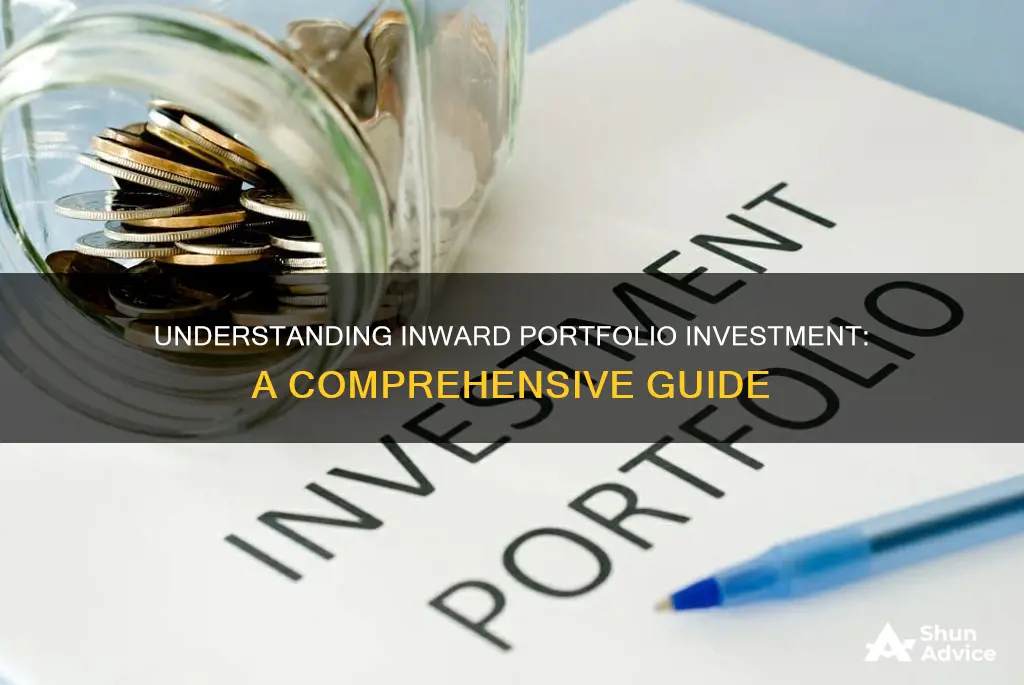
Inward portfolio investment is when foreign investors purchase securities and other financial assets in a local economy. It is a type of foreign investment, which is when capital flows from one country to another. Inward portfolio investment is passive and does not give investors direct ownership of a company's assets, instead allowing them to invest in stocks, bonds, mutual funds, and exchange-traded funds. It is distinct from foreign direct investment, which involves establishing a direct business interest in a foreign country, such as buying or building a manufacturing business. Inward portfolio investment is more liquid and accessible to the average investor, but it is also viewed less favourably than foreign direct investment as it can be sold off quickly and is often seen as a short-term move.
| Characteristics | Values |
|---|---|
| Definition | Inward investment refers to investment that comes into a country from abroad – from foreign investors who live in other countries. |
| Type | Foreign direct investment (FDI) is a common kind of inward investment. FDI differs from foreign portfolio investment (FPI) in that FDI has a notion of direct control. |
| Examples | FDI includes mergers and acquisitions, establishing a subsidiary or associate company in a foreign country, acquiring a controlling interest in an existing foreign company, or a merger or joint venture with a foreign company. |
| Impact | Inward investment creates jobs and brings wealth to the local economy. |
| Source | Inward investment often comes from multinational corporations. |
What You'll Learn

Foreign portfolio investment (FPI)
FPI is one of the common ways for investors to participate in an overseas economy, especially for retail investors. FPI holdings can include stocks, American depositary receipts (ADRs), global depositary receipts (GDRs), bonds, mutual funds, and exchange-traded funds.
FPI does not provide the investor with direct ownership of a company's assets and is relatively liquid depending on the volatility of the market. It also does not offer the investor control over the business entity in which the investment is made.
FPI is crucial for global diversification and provides investors with access to international markets, enhancing their potential for higher returns. By holding foreign assets, investors can spread risk and tap into diverse economic growth opportunities worldwide.
The United States Treasury Department conducts comprehensive surveys of foreign portfolio investment in long-term United States securities once every five years. The latest survey is the fifth survey conducted since their inception in 1974. The purposes of these surveys are to determine the level of foreign portfolio investment in the United States, the countries from which investments are made, the types of investments, the industries invested in, trends in foreign investment, and the income flows resulting from these investments.
Saving and Investing: Your Guide to Financial Freedom
You may want to see also

Foreign direct investment (FDI)
Inward investment involves an external or foreign entity investing in or purchasing the goods of a local economy. It is a way of bringing foreign money into a domestic economy. A common type of inward investment is foreign direct investment (FDI).
FDI can be made in several ways, including opening a subsidiary or associate company in a foreign country, acquiring a controlling interest in an existing foreign company, or through a merger or joint venture with a foreign company. The threshold for establishing a controlling interest is typically a minimum of 10% ownership stake in a foreign-based company, although this can vary depending on the structure of the company.
FDI is a key element in international economic integration, fostering stable and long-lasting links between economies. It can bring numerous benefits, such as economic growth, job creation, and infrastructure development in the recipient country, while also providing companies with expanded international operations and access to new markets.
However, FDI also comes with certain risks and challenges. It involves navigating the regulations and oversight of multiple governments, leading to a higher level of political risk. Additionally, FDI can have negative impacts on local small businesses, as they may struggle to compete with larger corporations entering the market.
Money Management: Spend, Save, and Invest Wisely
You may want to see also

Economic growth
Inward investment is the injection of foreign capital into a local economy. It is a catalyst for economic growth, bringing in foreign money, creating jobs, and developing infrastructure. Inward investment can be in the form of foreign direct investment (FDI) or foreign portfolio investment (FPI).
Foreign direct investment is a specific type of inward investment, where a foreign company establishes new operations or acquires an existing business in the local market. FDI is often undertaken by large corporations or institutions with substantial financial resources and a long-term commitment to the host country. It usually involves a significant amount of investment capital and is seen as a favourable investment that promotes the well-being of the host country. FDI can lead to the creation of new businesses or the expansion of existing ones, contributing to economic growth.
On the other hand, foreign portfolio investment refers to the purchase of financial assets such as stocks, bonds, and mutual funds by foreign investors. FPI is typically viewed as a short-term investment strategy, as it can be sold off quickly and does not provide control over the business entity. However, it is more accessible to average investors due to lower capital requirements and less extensive research. FPI can still contribute to economic growth by attracting foreign capital and providing liquidity to the local financial market.
Inward investments, including both FDI and FPI, have a positive impact on economic growth. They bring in foreign capital, create job opportunities, and develop infrastructure. Additionally, they can lead to technology transfers, skill development, and an increase in tax revenue for the host country. However, there are also potential drawbacks, such as the neglect of local small businesses and the potential for unsustainable development.
Overall, inward portfolio investment plays a crucial role in stimulating economic growth by attracting foreign capital, creating new business opportunities, and providing liquidity to financial markets. It is an essential aspect of international investment and can have far-reaching benefits for the host country's economy.
Creating Your First Investment Portfolio: A Beginner's Guide
You may want to see also

Inward investment vs outward investment
Inward investment refers to an external or foreign entity investing in or purchasing the goods of a local economy. It is foreign money that flows into the domestic economy. Inward investment is contrasted with outward investment, which is an outflow of investment capital from local entities to foreign economies.
Inward investment brings foreign capital to local economies, improving them through wealth creation, job creation, and infrastructure development. It often takes the form of foreign direct investment (FDI), where a foreign company purchases an existing company in a different country or establishes new operations for an existing business in that country. Inward investment can also take the form of foreign portfolio investment (FPI), which involves purchasing securities and other financial assets in another country.
Outward investment is the opposite of inward investment, where money flows out of the domestic economy and into foreign economies. Outward investment can take the form of FDI, where a company establishes a subsidiary or purchases a business in a foreign country. It can also take the form of FPI, where investors purchase financial assets such as stocks, bonds, and mutual funds in a foreign country.
While inward investment can bring many benefits to a country, such as economic growth, job creation, and tax revenue, there are also potential disadvantages. Inward investment may lead to unsustainable development, threaten existing small businesses, and disregard local practices and customs.
In summary, inward investment and outward investment refer to the direction of investment capital flow. Inward investment brings foreign capital into a local economy, while outward investment sends local capital to foreign economies. Both types of investment can take the form of FDI or FPI, with FDI tending to be a longer-term commitment and FPI offering more flexibility and quicker returns.
Smart Ways to Invest Your RBFCU Savings
You may want to see also

Inward investment in the US
Inward investment is when foreign money is injected into a local economy. It can be defined as the purchase of capital goods for a branch of a corporation to develop the economy in the region. Inward investment brings foreign capital into a country and is generally seen as a catalyst for economic growth.
Inward investment differs from outward investment, which is when investment capital flows from local entities to foreign economies. Inward investment is often a result of multinational corporations investing in foreign markets to expand their presence or meet specific demands of the local economy. A common type of inward investment is foreign direct investment (FDI), which involves the acquisition of an existing business or the establishment of new operations for an existing business in a foreign country.
The United States is the world's top destination for FDI, with a recorded increase of $506 billion, or 11.3%, in 2021. Total foreign direct investments into US businesses were $120.7 billion in 2020, a decrease of over 45% from 2019 due to the COVID-19 pandemic. Europe contributed over half of the new investments in 2020, with Germany and Canada being the largest contributors. Texas, California, and New Jersey received the largest investments among US states.
Inward investment has several advantages, including job creation, wealth generation, and infrastructure development. It helps local economies grow and facilitates international integration. However, critics argue that inward investment can lead to unsustainable development and negatively impact local small businesses.
Investing vs Saving: Understanding the Key Differences
You may want to see also
Frequently asked questions
Inward portfolio investment is the purchase of securities of foreign countries, such as stocks and bonds, on an exchange. It is a type of foreign investment, which involves capital flowing from one country to another.
Examples of inward portfolio investment include stocks, bonds, mutual funds, exchange-traded funds, American depositary receipts (ADRs), and global depositary receipts (GDRs).
Inward portfolio investment is a passive form of investment, where investors do not have direct control or management of the underlying assets. On the other hand, FDI involves establishing a direct business interest in a foreign country, such as acquiring or establishing a manufacturing business or purchasing buildings. FDI is typically a long-term investment, while inward portfolio investment is often considered a short-term move to make money.
Inward portfolio investment is more accessible to the average investor compared to FDI as it requires less capital and research. It also offers investors a chance for a quicker return on their investment and is more liquid, making it easier to sell.







